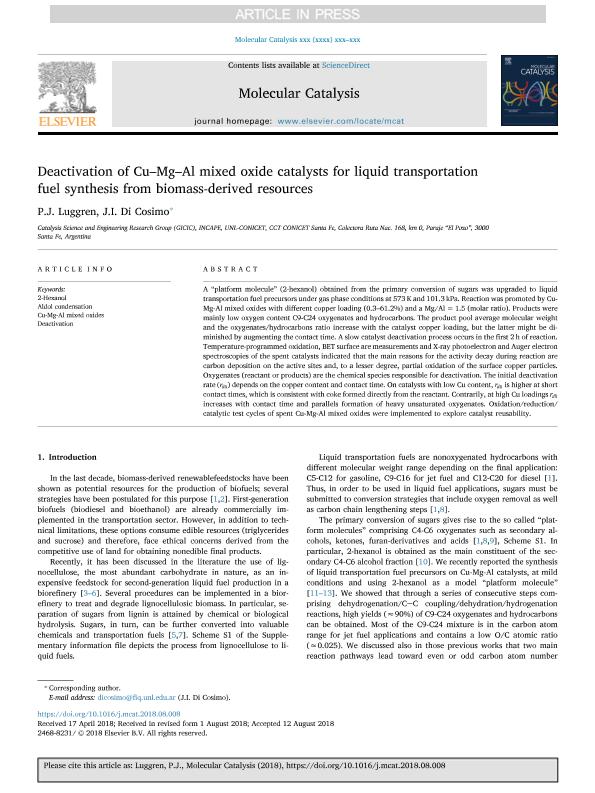Artículo
Deactivation of Cu–Mg–Al mixed oxide catalysts for liquid transportation fuel synthesis from biomass-derived resources
Fecha de publicación:
08/2018
Editorial:
Elsevier B.V.
Revista:
Molecular Catalysis
ISSN:
2468-8231
Idioma:
Inglés
Tipo de recurso:
Artículo publicado
Clasificación temática:
Resumen
A “platform molecule” (2-hexanol) obtained from the primary conversion of sugars was upgraded to liquid transportation fuel precursors under gas phase conditions at 573 K and 101.3 kPa. Reaction was promoted by Cu-Mg-Al mixed oxides with different copper loading (0.3–61.2%) and a Mg/Al = 1.5 (molar ratio). Products were mainly low oxygen content C9-C24 oxygenates and hydrocarbons. The product pool average molecular weight and the oxygenates/hydrocarbons ratio increase with the catalyst copper loading, but the latter might be diminished by augmenting the contact time. A slow catalyst deactivation process occurs in the first 2 h of reaction. Temperature-programmed oxidation, BET surface are measurements and X-ray photoelectron and Auger electron spectroscopies of the spent catalysts indicated that the main reasons for the activity decay during reaction are carbon deposition on the active sites and, to a lesser degree, partial oxidation of the surface copper particles. Oxygenates (reactant or products) are the chemical species responsible for deactivation. The initial deactivation rate (rd0) depends on the copper content and contact time. On catalysts with low Cu content, rd0 is higher at short contact times, which is consistent with coke formed directly from the reactant. Contrarily, at high Cu loadings rd0 increases with contact time and parallels formation of heavy unsaturated oxygenates. Oxidation/reduction/catalytic test cycles of spent Cu-Mg-Al mixed oxides were implemented to explore catalyst reusability.
Palabras clave:
2-HEXANOL
,
ALDOL CONDENSATION
,
CU-MG-AL MIXED OXIDES
,
DEACTIVATION
Archivos asociados
Licencia
Identificadores
Colecciones
Articulos(INCAPE)
Articulos de INST.DE INVEST.EN CATALISIS Y PETROQUIMICA "ING. JOSE MIGUEL PARERA"
Articulos de INST.DE INVEST.EN CATALISIS Y PETROQUIMICA "ING. JOSE MIGUEL PARERA"
Citación
Luggren, Pablo Jorge; Di Cosimo, Juana Isabel; Deactivation of Cu–Mg–Al mixed oxide catalysts for liquid transportation fuel synthesis from biomass-derived resources; Elsevier B.V.; Molecular Catalysis; 8-2018; 1-11
Compartir
Altmétricas




